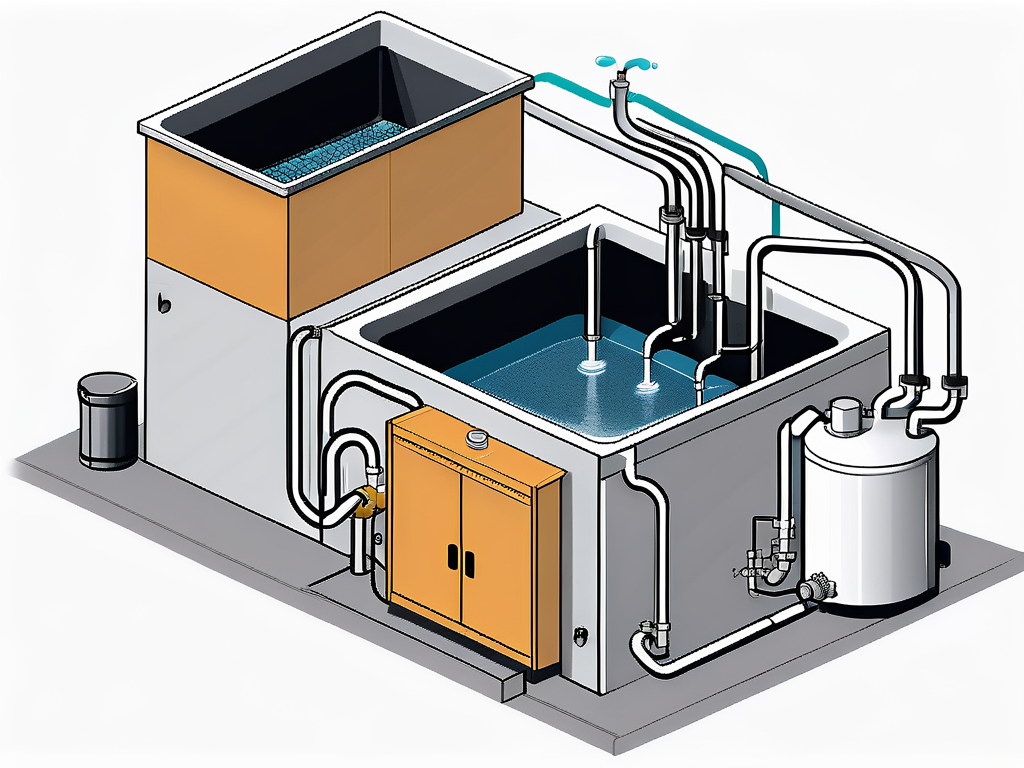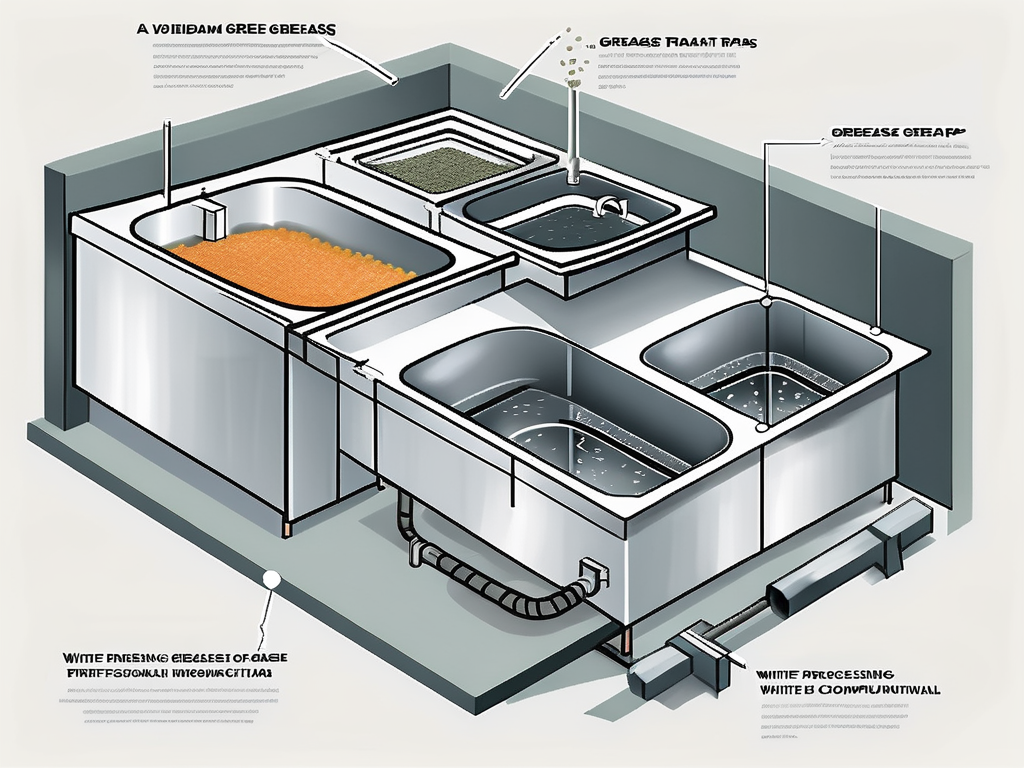
Grease Trap: Wastewater Treatment Explained
A grease trap, also known as a grease interceptor or grease recovery device, is a crucial component in the wastewater treatment process, particularly in commercial settings like restaurants and food processing facilities. This device is designed to intercept and trap fats, oils, and greases (FOG) from wastewater before it enters the sewer system. The prevention of FOG entering the sewer system is essential as it can cause blockages, leading to overflows and significant environmental damage.
The purpose of this glossary entry is to provide a comprehensive understanding of the grease trap, its role in wastewater treatment, how it works, and why it's important. We will also delve into the different types of grease traps, their installation and maintenance, and the regulations surrounding their use.
Role of Grease Traps in Wastewater Treatment
The primary role of a grease trap is to prevent FOG from entering the sewer system. When FOG enters the sewer, it can solidify and adhere to the pipe walls, causing blockages. These blockages can lead to sewer overflows, which can cause significant environmental damage and pose a public health risk. By trapping FOG, grease traps play a crucial role in maintaining the integrity of the sewer system and protecting the environment.
Additionally, grease traps also help to reduce the load on wastewater treatment plants. By removing FOG at the source, less treatment is required downstream, which can result in cost savings for wastewater treatment facilities. Furthermore, the trapped FOG can be recycled and used as a source of biofuel, contributing to a circular economy.
Environmental Impact of FOG
When FOG enters the sewer system and causes blockages, it can lead to sewer overflows. These overflows can result in untreated wastewater being discharged into the environment, which can contaminate water bodies, harm aquatic life, and pose a risk to public health. Additionally, the process of cleaning up these overflows can be costly and time-consuming.
Moreover, FOG can interfere with the biological processes at wastewater treatment plants. High levels of FOG can inhibit the growth of microorganisms that are essential for the breakdown of organic matter in wastewater. This can reduce the efficiency of the treatment process and increase the cost of treatment.
How Grease Traps Work
Grease traps work on the principle of gravity separation. As wastewater enters the grease trap, it cools down, causing the FOG to solidify and float to the top due to their lower density. The solidified FOG forms a layer at the top of the trap, while heavier solids settle at the bottom. The relatively clear water in the middle is then allowed to flow out of the trap and into the sewer system.

The trapped FOG and solids are retained in the grease trap until it is cleaned out. Regular cleaning is essential to prevent the trap from becoming full and ineffective. The frequency of cleaning depends on the size of the trap and the amount of FOG generated by the facility.
Components of a Grease Trap
A typical grease trap consists of several components, including an inlet pipe, baffles, a grease retention area, and an outlet pipe. The inlet pipe allows wastewater to enter the trap, while the baffles slow down the flow of water, allowing time for the FOG to separate. The grease retention area is where the FOG accumulates, while the outlet pipe allows the treated water to exit the trap.
Some grease traps also include a flow control device, which regulates the rate of wastewater entering the trap. This ensures that the water has sufficient time to cool down and the FOG has enough time to separate and float to the top.
Types of Grease Traps
There are several types of grease traps, each with their own advantages and disadvantages. The most common types include passive grease traps, automatic grease removal units, and gravity grease interceptors.

Passive grease traps are the simplest type and are typically used in smaller facilities. They rely solely on gravity to separate the FOG from the wastewater. Automatic grease removal units, on the other hand, use a mechanical system to automatically remove the trapped FOG, reducing the need for manual cleaning. Gravity grease interceptors are large, in-ground units that can handle high volumes of wastewater, making them suitable for larger facilities.
Choosing the Right Grease Trap
Choosing the right grease trap depends on several factors, including the size of the facility, the amount of FOG generated, and the local regulations. Smaller facilities with low FOG generation may be able to use a passive grease trap, while larger facilities or those with high FOG generation may require a gravity grease interceptor or an automatic grease removal unit.
It's also important to consider the maintenance requirements of the grease trap. Passive grease traps require regular manual cleaning, which can be labor-intensive and time-consuming. Automatic grease removal units, while more expensive upfront, can save time and labor costs in the long run due to their automatic cleaning feature.
Installation and Maintenance of Grease Traps
The installation of a grease trap should be carried out by a professional plumber to ensure it is installed correctly and in compliance with local regulations. The grease trap should be installed close to the source of FOG, such as the kitchen sink or dishwasher, to prevent the FOG from solidifying in the pipes before it reaches the trap.
Regular maintenance of the grease trap is crucial to ensure its effectiveness. This typically involves cleaning out the trapped FOG and solids, inspecting the trap for damage, and replacing worn-out parts. The frequency of maintenance depends on the size of the trap and the amount of FOG generated by the facility.
Professional Cleaning Services
Many facilities choose to hire a professional cleaning service to maintain their grease trap. These services have the necessary equipment and expertise to clean the trap effectively and dispose of the trapped FOG in an environmentally friendly manner. They can also provide regular maintenance checks to ensure the trap is functioning properly.
While hiring a professional cleaning service can be more expensive than doing it in-house, it can save time and labor costs and ensure compliance with local regulations. Additionally, many services provide documentation of the cleaning, which can be useful for regulatory compliance.
Regulations Surrounding Grease Traps
There are various regulations surrounding the use of grease traps, which vary by location. These regulations typically require facilities that generate FOG, such as restaurants and food processing plants, to install and maintain a grease trap. They may also specify the size and type of grease trap required, the frequency of cleaning, and the disposal of trapped FOG.
Non-compliance with these regulations can result in fines and penalties. Therefore, it's important for facilities to understand and comply with their local regulations. This may involve consulting with a professional plumber or a local regulatory agency.
Importance of Compliance
Compliance with grease trap regulations is not only a legal requirement, but it's also crucial for the protection of the environment and public health. By properly installing and maintaining a grease trap, facilities can prevent FOG from entering the sewer system, reducing the risk of blockages and overflows.
Additionally, compliance can also have financial benefits. By reducing the load on the wastewater treatment plant, facilities can lower their sewer charges. Furthermore, the trapped FOG can be recycled and used as a source of biofuel, providing an additional revenue stream.
Conclusion
In conclusion, grease traps play a vital role in wastewater treatment by preventing FOG from entering the sewer system. They work on the principle of gravity separation, trapping FOG and solids while allowing relatively clear water to flow into the sewer. There are various types of grease traps, each with their own advantages and disadvantages, and choosing the right one depends on several factors.
Regular maintenance of the grease trap is crucial to ensure its effectiveness, and many facilities choose to hire a professional cleaning service for this task. Compliance with local grease trap regulations is also important, not only for legal reasons but also for the protection of the environment and public health.



